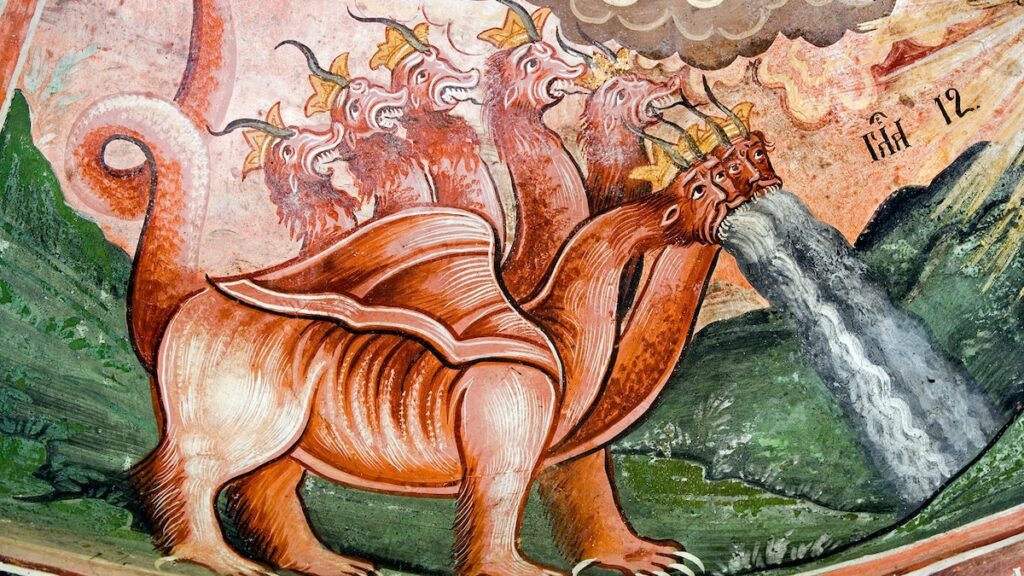Dragons appear in almost every culture on Earth. Some researchers suggest that dragons are born from our most primal fears—a terrifying blend of sharp claws, impenetrable scales, and pointy teeth—which were used by early humans to teach each other about the world’s dangers.
These mythical creatures have captivated human imagination for centuries, weaving their way into folklore, literature, and art across continents. But why do these ancient legends still hold such power over us today? Here are six epic legends that show why dragons continue to ignite our imagination.
Ngwhi—The original dragon of mythology
Ngwhi, a serpent-like deity in various mythologies, inspired concepts like Valhalla and the Midgard Serpent, seen in this 16th-century painting.
Photograph by Arni Magnusson Institute, Bridgeman Images
Ngwhi—or “*H₂n̥gʷʰ in Proto-Indo-European—could be considered the original dragon. Dating back 4,000 to 6,000 years, PIE myths describe Ngwhi (“serpent”) as a three-headed beast that abducts cattle or, in some tales, women. This could be the origin of the familiar pop-culture trope of dragons kidnapping princesses. Ultimately, the multi-headed monster is defeated by a hero empowered by an intoxicating drink and assisted by a sky god.
Today, traces of this story can be found everywhere, from the Norse myth of the thunder god Thor capturing the giant serpent Jörmungandr using an ox head as bait to the Japanese tale of the storm god Susanoo slaying the eight-headed serpent-dragon Yamata-no-Orochi, which devoured young girls, after first getting it drunk on sake.
The Beast—the most powerful representation of evil
The Beatus of León, an 11th-century illuminated manuscript of Beatus of Liébana’s Commentary on the Apocalypse, features stunning illustrations, including the iconic red dragon.
Photograph by Pictures from History, Bridgeman Images
One of the most renowned dragons appears in the Book of Revelations. This “enormous red dragon” with seven heads and 10 horns brings about the Apocalypse. Stories of saints like St. George slaying dragons reinforced the idea of dragons as enemies of the righteous.
(Dreaming of dragons? Here’s where they really live.)
However, according to Jess Nevins, research librarian and author of Encyclopedia of Fantastic Victoriana, “the roots of Western dragon mythology lie in ancient Mesopotamia.” These early dragon myths were likely influenced by the presence of dangerous wildlife, such as venomous snakes, which posed a real threat to ancient peoples, says Nevins.
Ancalagon the Black—the world’s largest dragon
Smaug, known as Smaug the Magnificent, is one of the last great dragons of Middle-earth and the primary antagonist in J.R.R. Tolkien’s “The Hobbit.” Fans estimate his size to be about 60 feet long, roughly the length of a big rig truck. In contrast, the cinematic version of Smaug in Peter Jackson’s film adaptation was significantly larger, 427 feet long, or about the size of two jumbo jets.
But even that version is dwarfed by Ancalagon the Black, described in “The Silmarillion,” as the largest and most powerful dragon ever to exist in Middle-earth. Some interpretations suggest he could have been up to 15 miles long, and his fall caused the destruction of three volcanoes.
Ancalagon was also feared for his fire breath, a classic dragon trope with a fascinating history. “The fiery breath of dragons was an innovation of The Letter of Alexander to Aristotle,” says Nevins. The fictional accounts of Alexander the Great’s adventures mention giant serpents with breath “like a burning torch.”
Ryujin—supreme dragon god of the oceans
This 19th-century print shows Princess Tamatori, a pearl diver, being chased by Ryujin, the Japanese sea dragon.
Photograph by Pictures from History, Bridgeman Images
One of the most powerful deities in Japanese mythology is Ryujin, the fearsome dragon god of the oceans, known for his ability to control storms and all sea life. Ryujin’s influence extends to various fictional characters and settings, notably inspiring the underwater Dragon Palace featured in the popular anime series “One Piece.”
(See a real “house of dragons” in this Slovenian cave.)
Ryujin is a rare example of a Japanese dragon associated with fire, suggesting that his design elements may have influenced the iconic creature Godzilla.
Additionally, Ryujin is considered an ancestral figure of the Japanese Imperial Family, which traces its lineage back to Emperor Jimmu (711 – 585 B.C.), the legendary first ruler of Japan and a great-grandson of Ryujin.
Qijianglong—the most dragon-like dinosaur
The discovery of dinosaur bones, particularly in China, likely influenced the development of dragon myths. China is rich in fossils of mamenchisaurids, dinosaurs known for their incredibly long necks.
A notable example is the Qijianglong, or “dragon of Qijiang,” discovered in 2006. It had a 50-foot-long body, much of which was dedicated to supporting its massive head. Its neck vertebrae were filled with air, making them lightweight and potentially leading to detachment after death.
Ancient Chinese people may have encountered these enormous bones and envisioned the long, serpentine dragons characteristic of Asian mythology, contrasting with the bulkier dragons in Western folklore.
Apep—the archetype of ancient dragons
Apep, also known as Apophis, was a god in ancient Egyptian religion, represented as a serpent or dragon. He embodied darkness and disorder, opposing the forces of order and light, personified by the goddess Ma’at and the sun god Ra.
Photograph by Pictures from History, Bridgeman Images
“Dragons…were more often associated with the gods,” says Nevins. In Ancient Egypt, the deity Apep embodies the archetype of a dragon, perhaps one of the most formidable in mythology.
Known also as Apophis, this colossal serpent represents an archetype of ancient dragons and demons, existing since the dawn of time. Apep, the “Lord of Chaos,” engages in an eternal struggle against Ra, the solar deity, in a relentless bid to cast the world into perpetual darkness.
(These dragons don’t breathe fire—but they’re very real.)
Despite its repeated defeat, Apep never succumbs, returning daily with its hypnotic gaze, orchestrating earthquakes and thunderstorms to maintain its sinister dominion, all in pursuit of extinguishing the very source of light—the Sun itself.
>>> Read full article>>>
Copyright for syndicated content belongs to the linked Source : National Geographic – https://www.nationalgeographic.com/history/article/dragons-myths-from-around-the-world
